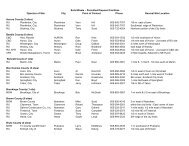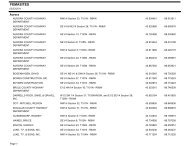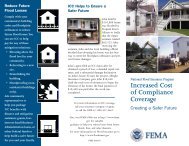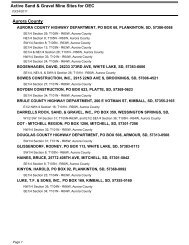Repairing Your Flooded Home PDF - American Red Cross
Repairing Your Flooded Home PDF - American Red Cross
Repairing Your Flooded Home PDF - American Red Cross
- No tags were found...
Create successful ePaper yourself
Turn your PDF publications into a flip-book with our unique Google optimized e-Paper software.
4S T E PDry Out <strong>Your</strong> <strong>Home</strong>Desiccants like those listedbelow are usually available athardware, grocery, or drugstores.• Chemical dehumidifier packsused for drying boats anddamp closets.• Cat litter made of clay.• Calcium chloride pellets usedfor melting ice in the winter.Hang pellets in a pillow case,nylon stocking, or otherporous bag. Put a bucketunderneath to catch drippingwater. Close the closet orarea being dried. Be careful.Calcium chloride can burnyour skin. It will also makethe air salty, so do not usethis product near computersor other delicate equipment.❑ Call a contractor. There arecontractors who specialize indrying out flooded buildings.They have large fans and dehumidifiersthat can dry out ahouse in a few days. Look inthe yellow pages under Fire andWater Damage Restoration orunder Dehumidifying. Becareful about contractors whoinflate prices after a disaster andabout out-of-town contractorswho inflate prices after adisaster and about out-of-towncontractors who request paymentin advance.Be patient. Drying your homecould take several weeks. Untilyour home is reasonably dry, damagecaused by mildew and decaywill continue. The musty odorwill remain forever if the home isnot thoroughly dried out well.Sort Contents and DiscardDebrisYou have three types of contentsthat should go to three differentplaces:• items you want to save• items to be discarded• garbageThings you want to saveMove these to a safe, dry place,such as the second story or outside.The longer they sit in water,the more damaged they become.In some cases, you may only beable to move them to one roomwhile you clean the other rooms.Don’t leave wood furniture in thesun or it will warp when it dries.To save an area rug, lay a sheet orsome other material on top so thecolors will not bleed. Clean itpromptly.Things you don’t want to savePut things you don’t want to saveoutside to dry until the adjustercomes to confirm your losses.Take pictures or videotapes andlist each item for the record. Ifyou are not sure whether to throwsomething out, decide whether itis worth salvaging by checking theinformation in Step 6.GarbageGet rid of food and anything elsethat could spoil or go bad immediately.Don’t let garbage buildup. Garbage piles will cause yetanother health hazard by attractinganimals and insects. If yourinsurance adjuster has not come,tell your agent or adjuster that youneed to get rid of potential healthhazards. That person will tell youItems Soaked by FloodwaterShould I Throw them Out?UsuallyMattresses, pillows, foam rubber,large carpets, carpet padding,upholstered couches and chairs,books, paper productsAlwaysFood, cosmetics, medical supplies,stuffed animals, baby toysQuestions about the Safetyof <strong>Your</strong> Food?Call the USDA Food SafetyHotline: 1-800-535-4555Professional home economists willanswer your questions from 10 a.m.to 4 p.m. eastern time, Mondaythrough Friday.Questions About the Safetyof <strong>Your</strong> Food?Call the USDA Food Safety Hotline:1-800-535-4555Professional home economists willanswer your questions from 10 a.m.to 4 p.m. eastern time, Mondaythrough Friday.20







